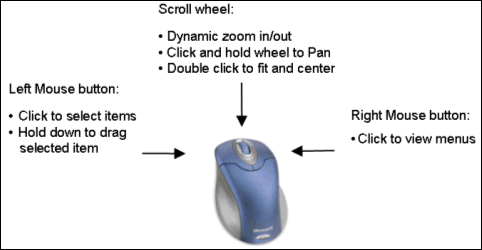Navigating in Revu
Revu provides numerous methods for navigating, panning, and zooming in and out of a document.
The primary method for navigating is the mouse. Revu works with all types of mice, however it is suggested that you use a 3 button mouse with a scroll wheel for the optimum performance. The following diagram identifies how the mouse buttons are used.

The scroll wheel is a convenient way to zoom in and out of a PDF, but be aware that it can also scroll up and down the page based on your current Navigation Preferences and page mode.
Double-click the scroll wheel to fit the entire PDF page to the current workspace window.
Double-click the left mouse button (or double-tap a tablet PC stylus) to display the tablet zoom control.

To scroll using the tablet zoom control, click and hold in the blue-shaded area, then drag the cursor up or down to zoom. Click outside the blue area to exit the control and pan the document.
Navigation Keyboard shortcuts:
- Zoom out — CTRL+MINUS
- Zoom in — CTRL+PLUS
- Actual Size — CTRL+8
- Fit Page — CTRL+9
- Fit Width — CTRL+0
- Select Zoom tool — Z
- Toggle between Pan or Select tool and Zoom tool — SHIFT+Z
Click and hold the scroll wheel down to pan the document.
Click and drag the horizontal and vertical scroll bars as you would in any Windows application.
Press the LEFT ARROW, RIGHT ARROW, UP ARROW and DOWN ARROW keys.
The Navigation bar along the bottom of the workspace typically holds the Pan

To zoom in on a particular area of a document, click the  Zoom tool or press Z, then click and drag a rectangle over the desired area. Upon release, the defined area will zoom to fill the workspace.
Zoom tool or press Z, then click and drag a rectangle over the desired area. Upon release, the defined area will zoom to fill the workspace.
To pan around the document, click the  Pan tool or press ESC, then click and drag to move the view in the main workspace.
Pan tool or press ESC, then click and drag to move the view in the main workspace.
It is also possible to set the zoom level manually to a percentage, or to automatically fit the width or the whole page. To do so, select a zoom value from the zoom list  and choose a specific page size percentage. To zoom to a setting rather than a percentage, choose one of the options at the bottom of the list (Actual Size, Fit Page, or Fit Width).
and choose a specific page size percentage. To zoom to a setting rather than a percentage, choose one of the options at the bottom of the list (Actual Size, Fit Page, or Fit Width).
To jump between pages and views, use the tools on the right side of the Navigation bar. These buttons are designed to provide efficient movement between pages and views in the workspace.

Each of the buttons is explained below:
 First Page (HOME): Click to jump to the first page of the PDF.
First Page (HOME): Click to jump to the first page of the PDF.
 Previous Page (
Previous Page (
 Page Number: Indicates the current location in the PDF.
Page Number: Indicates the current location in the PDF.
 Next Page (
Next Page (
 Last Page (END): Click to jump to the last page of the document.
Last Page (END): Click to jump to the last page of the document.
 Previous View (ALT+LEFT ARROW): Click to go back to the previous view in the main workspace.
Previous View (ALT+LEFT ARROW): Click to go back to the previous view in the main workspace.
 Next View (ALT+RIGHT ARROW): Click to go to the next view in the main workspace.
Next View (ALT+RIGHT ARROW): Click to go to the next view in the main workspace.
The Thumbnails panel is ideal for navigating large PDFs with many pages. Open the Thumbnails panel and click a page's thumbnail to jump directly to it.
Many PDFs come with bookmarks for quick navigation to sections of the document. Find a document's bookmarks on the Bookmarks panel. To jump to a bookmark's location, click it.
Flags provide a mechanism for easily navigating to specific pages and places in a PDF and are available in the Flags panel. While similar to bookmarks, flags are meant to call attention to something specific in the document and are generally added and removed more freely than bookmarks. Open the Flags panel and click a flag to jump to its location. See the Flag panel section for more information.